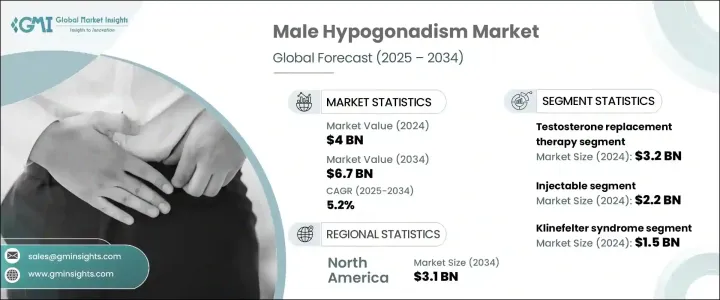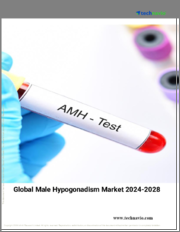
|
시장보고서
상품코드
1698248
남성 성선기능저하증 시장 : 시장 기회, 성장 촉진요인, 산업 동향 분석, 예측(2025-2034년)Male Hypogonadism Market Opportunity, Growth Drivers, Industry Trend Analysis, and Forecast 2025-2034 |
||||||
세계의 남성 성선기능저하증 시장은 2024년에 40억 달러로 평가되었으며, 2025-2034년 연평균 복합 성장률(CAGR) 5.2%로 성장할 것으로 예측됩니다.
성장의 원동력이 되는 것은 호르몬 균형의 혼란에 대한 의식의 고조, 진단 능력의 진보, 테스토스테론 결핍증의 유병률 상승입니다. 이 증상은 체내에서 테스토스테론이 충분히 생성되지 않거나 고환이 제대로 작동하지 않을 때 발생해 신체적, 성적, 심리적으로 중대한 합병증을 일으킵니다. 테스토스테론은 많은 남성 생리 기능에서 중요한 역할을 담당하고 있기 때문에 그 결핍은 전체적인 건강, 에너지 수준, 삶의 질에 악영향을 미칠 수 있습니다.

이 성장에 박차를 가하고 있는 주요 요인은 의학적 개입을 필요로 하는 호르몬 변화를 경험하는 고령 남성이 증가하고 있는 것입니다. 게다가 헬스케어 인프라의 개선 및 규제의 골조가 정비됨으로써, 선진적인 치료법이 보다 이용하기 쉬워지고 있습니다. 지속적인 연구개발 노력으로 치료 효과가 향상되고 환자의 전귀가 개선되며 처방된 치료법이 장기간에 걸쳐 준수되고 있습니다. 헬스케어 공급자들은 테스토스테론 결핍증을 관리하기 위한 혁신적인 솔루션에 점점 더 주목하게 되고 있으며, 세계 치료 채용의 급증으로 이어지고 있습니다.
| 시장 범위 | |
|---|---|
| 시작 연도 | 2024년 |
| 예측 연도 | 2025-2034년 |
| 시작 금액 | 40억 달러 |
| 예측 금액 | 67억 달러 |
| CAGR | 5.2% |
남성 호르몬 보충 요법은 여전히 지배적인 치료 접근법이며 2024년에는 32억 달러의 수익을 창출했습니다. 이 분야는 호르몬 요법이 수용되고 치료 옵션에 대한 접근이 용이해진 데 힘입어 2034년까지 CAGR 5.3%로 확대될 것으로 예상됩니다. 남성호르몬 보충은 호르몬 수준을 정상으로 되돌리고 성 기능, 근육량, 기분, 전체적인 행복감을 개선하는 데 도움이 됩니다. 주사제, 국소겔제, 경구제 등 다양한 투여 경로를 이용할 수 있기 때문에 환자는 자신의 라이프스타일과 의료 요구에 맞는 치료를 선택할 수 있습니다. 호의적인 상환 정책 및 보험 적용도 시장 확대의 추진에 매우 중요한 역할을 하고 있어 제약회사의 연구 및 혁신에 대한 투자를 재촉하고 있습니다.
투여 경로에 따라 시장은 주사요법, 국소요법, 경구요법으로 구분됩니다. 테스토스테론 주사 요법은 55.3%의 시장 점유율을 차지하며 2024년에는 22억 달러에 이르렀습니다. 이러한 치료는 안정적인 호르몬 수준을 유지하고 기분 저하, 피로, 성욕 문제를 일으킬 수 있는 변동을 방지하는 능력이 있기 때문에 널리 선호되고 있습니다. 의사들이 주사제를 선호하는 것은 투여량 조정이 정확하기 때문이며 잠재적 부작용을 최소화하면서 호르몬 수준을 최적화하는 개별화된 치료 계획을 가능하게 합니다. 그 결과, 이러한 치료에 대한 환자의 건강 관리는 여전히 높고, 시장의 성장은 더욱 강해지고 있습니다.
북미는 계속해서 주요 지역 시장으로, 2024년에는 18억 달러의 매출을 올렸으며, 2034년에는 31억 달러에 이를 것으로 예상되고 있습니다. 미국이 최대의 점유율을 차지해 2023년에는 16억 달러의 공헌이 되었습니다. 호르몬 결핍증으로 고민하는 고령 남성의 증가가 이 지역 시장 수요의 주요 촉진 요인이 되고 있습니다. 엄격한 규제 기준으로 고품질의 안전하고 효과적인 치료제를 구할 수 있습니다. 게다가 계발 캠페인의 확대, 헬스케어 지출의 증가, 의학 연구의 진보가 시장 확대를 지지하고 있습니다. 의료제공자가 환자 중심의 치료 접근법을 우선시하는 가운데 혁신적인 치료법 및 엄격한 품질관리 조치가 계속 시장정세를 형성해 테스토스테론 결핍증에 걸린 사람들의 전귀 개선을 확실히 합니다.
목차
제1장 조사 방법 및 조사 범위
제2장 주요 요약
제3장 업계 인사이트
- 생태계 분석
- 업계에 미치는 영향요인
- 성장 촉진요인
- 인지 및 진단 증가
- 성선기능저하증의 이환율 상승
- 테스토스테론 보충 요법 진보
- 남성의 건강 및 웰니스 프로그램의 성장
- 업계의 잠재적 위험 및 과제
- 안전에 대한 우려 및 부작용
- 엄격한 규제 준수
- 성장 촉진요인
- 성장 가능성의 분석
- 규제 상황
- 파이프라인 분석
- 갭 분석
- 특허 분석
- Porter's Five Forces 분석
- PESTEL 분석
제4장 경쟁 구도
- 서문
- 기업 점유율 분석
- 기업 매트릭스 분석
- 주요 시장 기업의 경쟁 분석
- 경쟁 포지셔닝 매트릭스
- 전략 대시보드
제5장 시장 추계 및 예측 : 치료 유형별(2021-2034년)
- 주요 동향
- 남성 호르몬 보충 요법
- 고나도트로핀 요법
제6장 시장 추계 및 예측 : 투여 경로별(2021-2034년)
- 주요 동향
- 주사
- 외용
- 경구
제7장 시장 추계 및 예측 : 용도별(2021-2034년)
- 주요 동향
- 칼만 증후군
- 클라인펠터 증후군
- 뇌하수체 질환
- 기타 용도
제8장 시장 추계 및 예측 : 지역별(2021-2034년)
- 주요 동향
- 북미
- 미국
- 캐나다
- 유럽
- 독일
- 영국
- 프랑스
- 스페인
- 이탈리아
- 네덜란드
- 아시아태평양
- 중국
- 일본
- 인도
- 호주
- 한국
- 라틴아메리카
- 브라질
- 멕시코
- 아르헨티나
- 중동 및 아프리카
- 남아프리카
- 사우디아라비아
- 아랍에미리트(UAE)
제9장 기업 프로파일
- AbbVie
- Bayer
- Eli Lilly and Company
- Endo Pharmaceuticals
- Ferring Holdings
- Perrigo Company
- Pfizer
- Sanofi
- Teva Pharmaceutical Industries
- Viatris
The Global Male Hypogonadism Market was valued at USD 4 billion in 2024 and is projected to grow at a CAGR of 5.2% from 2025 to 2034. The growth is driven by increasing awareness of hormonal imbalances, advancements in diagnostic capabilities, and the rising prevalence of testosterone deficiency. This condition occurs when the body fails to produce adequate testosterone or when the testes do not function properly, leading to significant physical, sexual, and psychological complications. Since testosterone plays a crucial role in numerous male physiological functions, its deficiency can negatively impact overall health, energy levels, and quality of life.

A key factor fueling this growth is the increasing number of aging men experiencing hormonal changes that require medical intervention. Additionally, improved healthcare infrastructure and supportive regulatory frameworks are making advanced therapies more accessible. Ongoing research and development efforts are enhancing treatment efficacy, ensuring better patient outcomes and long-term adherence to prescribed therapies. Healthcare providers are increasingly focusing on innovative solutions to manage testosterone deficiency, leading to a surge in treatment adoption worldwide.
| Market Scope | |
|---|---|
| Start Year | 2024 |
| Forecast Year | 2025-2034 |
| Start Value | $4 Billion |
| Forecast Value | $6.7 Billion |
| CAGR | 5.2% |
Testosterone replacement therapy remains the dominant treatment approach, generating USD 3.2 billion in revenue in 2024. This segment is expected to expand at a CAGR of 5.3% through 2034, supported by the growing acceptance of hormone therapy and easier access to treatment options. Testosterone replacement helps restore normal hormone levels, improving sexual function, muscle mass, mood, and overall well-being. The availability of different administration routes, including injectables, topical gels, and oral formulations, ensures that patients can choose a treatment that aligns with their lifestyle and medical needs. Favorable reimbursement policies and insurance coverage have also played a pivotal role in driving market expansion, encouraging pharmaceutical companies to invest in research and innovation.
Based on the route of administration, the market is segmented into injectable, topical, and oral therapies. Injectable testosterone therapies accounted for a 55.3% market share, reaching USD 2.2 billion in 2024. These treatments are widely preferred for their ability to maintain stable hormone levels, preventing fluctuations that could cause mood swings, fatigue, and libido issues. Physicians favor injectable formulations due to their precision in dosage adjustments, allowing for personalized treatment plans that optimize hormone levels while minimizing potential side effects. As a result, patient adherence to these therapies remains high, further strengthening market growth.
North America continues to be a leading regional market, generating USD 1.8 billion in revenue in 2024 and expected to reach USD 3.1 billion by 2034. The U.S. accounted for the largest share, contributing USD 1.6 billion in 2023. The rising number of aging men dealing with hormonal deficiencies is a major driver of market demand in this region. Strict regulatory standards ensure the availability of high-quality, safe, and effective therapies. Additionally, growing awareness campaigns, increased healthcare spending, and advancements in medical research are supporting market expansion. As healthcare providers prioritize patient-centric treatment approaches, innovative therapies and stringent quality control measures will continue to shape the market landscape, ensuring improved outcomes for individuals affected by testosterone deficiency.
Table of Contents
Chapter 1 Methodology and Scope
- 1.1 Market scope and definitions
- 1.2 Research design
- 1.2.1 Research approach
- 1.2.2 Data collection methods
- 1.3 Base estimates and calculations
- 1.3.1 Base year calculation
- 1.3.2 Key trends for market estimation
- 1.4 Forecast model
- 1.5 Primary research and validation
- 1.5.1 Primary sources
- 1.5.2 Data mining sources
Chapter 2 Executive Summary
- 2.1 Industry 360° synopsis
Chapter 3 Industry Insights
- 3.1 Industry ecosystem analysis
- 3.2 Industry impact forces
- 3.2.1 Growth drivers
- 3.2.1.1 Increasing awareness and diagnosis
- 3.2.1.2 Rising incidence of hypogonadism
- 3.2.1.3 Advancements in testosterone replacement therapies
- 3.2.1.4 Growth in men’s health and wellness programs
- 3.2.2 Industry pitfalls and challenges
- 3.2.2.1 Safety concerns and side effects
- 3.2.2.2 Stringent regulatory compliance
- 3.2.1 Growth drivers
- 3.3 Growth potential analysis
- 3.4 Regulatory landscape
- 3.5 Pipeline analysis
- 3.6 Gap analysis
- 3.7 Patent analysis
- 3.8 Porter’s analysis
- 3.9 PESTEL analysis
Chapter 4 Competitive Landscape, 2024
- 4.1 Introduction
- 4.2 Company market share analysis
- 4.3 Company matrix analysis
- 4.4 Competitive analysis of major market players
- 4.5 Competitive positioning matrix
- 4.6 Strategy dashboard
Chapter 5 Market Estimates and Forecast, By Treatment Type, 2021 – 2034 ($ Mn)
- 5.1 Key trends
- 5.2 Testosterone replacement therapy
- 5.3 Gonadotropin therapy
Chapter 6 Market Estimates and Forecast, By Route of Administration, 2021 – 2034 ($ Mn)
- 6.1 Key trends
- 6.2 Injectable
- 6.3 Topical
- 6.4 Oral
Chapter 7 Market Estimates and Forecast, By Application, 2021 – 2034 ($ Mn)
- 7.1 Key trends
- 7.2 Kallmann syndrome
- 7.3 Klinefelter syndrome
- 7.4 Pituitary disorders
- 7.5 Other applications
Chapter 8 Market Estimates and Forecast, By Region, 2021 – 2034 ($ Mn)
- 8.1 Key trends
- 8.2 North America
- 8.2.1 U.S.
- 8.2.2 Canada
- 8.3 Europe
- 8.3.1 Germany
- 8.3.2 UK
- 8.3.3 France
- 8.3.4 Spain
- 8.3.5 Italy
- 8.3.6 Netherlands
- 8.4 Asia Pacific
- 8.4.1 China
- 8.4.2 Japan
- 8.4.3 India
- 8.4.4 Australia
- 8.4.5 South Korea
- 8.5 Latin America
- 8.5.1 Brazil
- 8.5.2 Mexico
- 8.5.3 Argentina
- 8.6 Middle East and Africa
- 8.6.1 South Africa
- 8.6.2 Saudi Arabia
- 8.6.3 UAE
Chapter 9 Company Profiles
- 9.1 AbbVie
- 9.2 Bayer
- 9.3 Eli Lilly and Company
- 9.4 Endo Pharmaceuticals
- 9.5 Ferring Holdings
- 9.6 Perrigo Company
- 9.7 Pfizer
- 9.8 Sanofi
- 9.9 Teva Pharmaceutical Industries
- 9.10 Viatris













